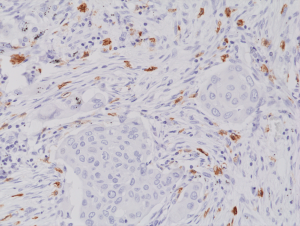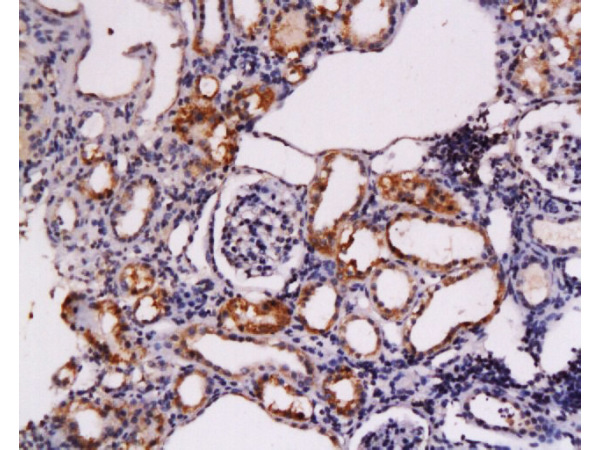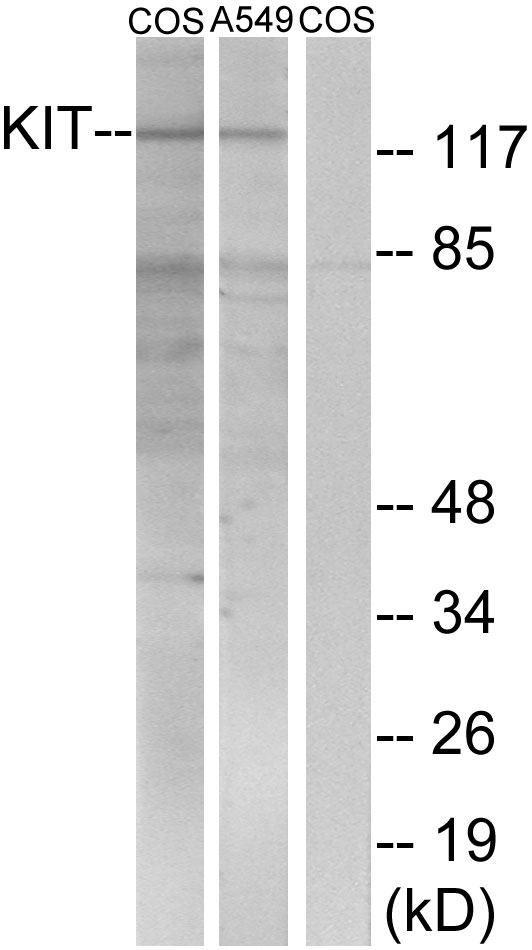
Immunohistochemical staining of formalin fixed and paraffin embedded human lung cancer tissue section using anti-CD117/c-Kit rabbit monoclonal antibody (Clone RM359) at a 1:2000 dilution.
anti-CD117 (human), Rabbit Monoclonal (RM359)
REV-31-1245-00
ApplicationsWestern Blot, ImmunoHistoChemistry
Product group Antibodies
ReactivityHuman
TargetKIT
Overview
- SupplierRevMAb Biosciences
- Product Nameanti-CD117 (human), Rabbit Monoclonal (RM359)
- Delivery Days Customer10
- ApplicationsWestern Blot, ImmunoHistoChemistry
- CertificationResearch Use Only
- ClonalityMonoclonal
- Clone IDRM359
- Gene ID3815
- Target nameKIT
- Target descriptionKIT proto-oncogene, receptor tyrosine kinase
- Target synonymsC-Kit, CD117, MASTC, PBT, SCFR, mast/stem cell growth factor receptor Kit, c-Kit protooncogene, p145 c-kit, piebald trait protein, proto-oncogene c-Kit, proto-oncogene tyrosine-protein kinase Kit, tyrosine-protein kinase Kit, v-kit Hardy-Zuckerman 4 feline sarcoma viral oncogene homolog, v-kit Hardy-Zuckerman 4 feline sarcoma viral oncogene-like protein
- HostRabbit
- IsotypeIgG
- Protein IDP10721
- Protein NameMast/stem cell growth factor receptor Kit
- Scientific DescriptionCD117 (c-Kit;; Stem cell growth factor receptor; SCFR) is a trans membrane type III tyrosine kinase receptor encoded by the c-Kit proto-oncogene, located on chromosome 4 in humans. It is expressed in hematopoietic stem cells, germ cells, mast cells and gastrointestinal tract cajal cells. Overexpression or mutations of this protein can lead to cancer. Upon binding of its ligand stem cell factor (SCF), CD117 dimerizes, resulting in receptor activation and autophosphorylation of various tyrosine residues including tyrosine 703 located on the cytoplasmic domain of the receptor. This modification allows docking of Grb2 and activation of the Ras/ERK signaling pathway. SCF/CD117 can activate multiple downstream signaling pathways including PI3K, PLC-gamma and JAK/STAT. Signaling through CD117 plays a role in cell survival, proliferation, and differentiation. CD117 receptor activation is essential for hematopoiesis, stem cell maintenance and gametogenesis. Activating mutations in this gene are associated with gastrointestinal stromal tumors, testicular seminoma, mast cell disease, melanoma, acute myeloid leukemia, while inactivating mutations are associated with the genetic defect piebaldism. Antibodies to CD117 are widely used in immunohistochemistry to help distinguish particular types of tumour in histological tissue sections. - Recombinant Antibody. This antibody reacts human CD117/c-Kit. Applications: WB, IHC. Source: Rabbit. Liquid. 50% Glycerol/PBS with 1% BSA and 0.09% sodium azide. CD117 (c-Kit;; Stem cell growth factor receptor; SCFR) is a trans membrane type III tyrosine kinase receptor encoded by the c-Kit proto-oncogene, located on chromosome 4 in humans. It is expressed in hematopoietic stem cells, germ cells, mast cells and gastrointestinal tract cajal cells. Overexpression or mutations of this protein can lead to cancer. Upon binding of its ligand stem cell factor (SCF), CD117 dimerizes, resulting in receptor activation and autophosphorylation of various tyrosine residues including tyrosine 703 located on the cytoplasmic domain of the receptor. This modification allows docking of Grb2 and activation of the Ras/ERK signaling pathway. SCF/CD117 can activate multiple downstream signaling pathways including PI3K, PLC-gamma and JAK/STAT. Signaling through CD117 plays a role in cell survival, proliferation, and differentiation. CD117 receptor activation is essential for hematopoiesis, stem cell maintenance and gametogenesis. Activating mutations in this gene are associated with gastrointestinal stromal tumors, testicular seminoma, mast cell disease, melanoma, acute myeloid leukemia, while inactivating mutations are associated with the genetic defect piebaldism. Antibodies to CD117 are widely used in immunohistochemistry to help distinguish particular types of tumour in histological tissue sections.
- ReactivityHuman
- Storage Instruction-20°C
- UNSPSC12352203






